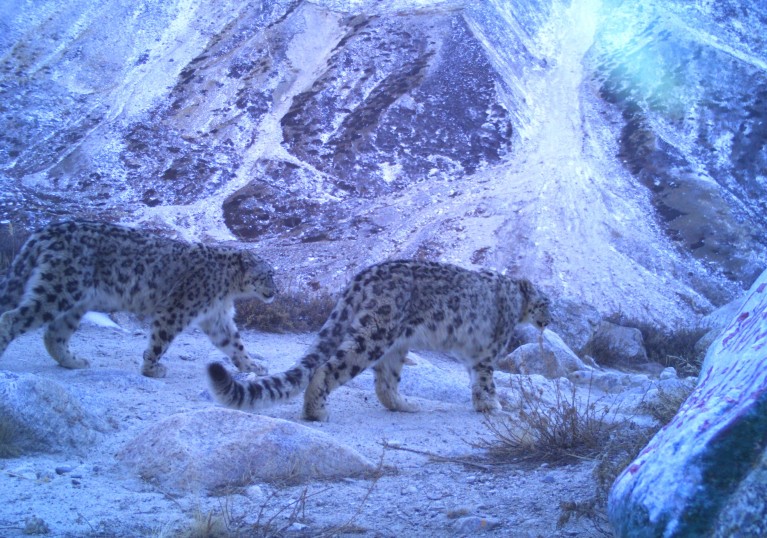
Over half of the snow leopard population is outside protected areas. Credit: Wildlife Institute of India
Watch camera trap images and videos of the snow leopards (Courtesy: WII)
The first scientific estimate of snow leopards, setting the stage for long-term monitoring of the species, reveals that 718 big cats roam the ice-capped mountains of the Indian Himalaya.
The Wildlife Institute of India-led Snow Leopard Population Assessment in India (SPAI) suggests this number accounts for roughly 10-15% of the global population of this enigmatic species.
“This provides baseline data on the population status of snow leopards in India,” said wildlife biologist Sambandam Sathyakumar at the institute. The exercise will be carried out every 4 years for continuous monitoring.
Previous estimates put the number of Indian snow leopards between 400 and 700.
The latest survey is based on more than two million pictures and eyewitness accounts and covers 70% of the snow leopard range in the country. Cameras were deployed in nearly 2000 locations close to leopard signs such as scat, sprays, and scrape marks between 2019 and 2023. These cameras captured rare videos of the big cats and other wildlife in Himachal Pradesh, Uttarakhand, Sikkim, Arunachal Pradesh, Ladakh, and Jammu and Kashmir.
241 of these snow leopards were marked unique based on the patterns on their foreheads. The cats occupy almost 94000 square kilometres across the Indian states and union territories studied. They prowl the non-forested tracks in altitudes between 3,200 and 5,200 metres, and feed primarily on blue sheep and Asian ibex, a large wild goat.
“Snow leopard presence or absence at a particular altitude in the Himalayas is a good indicator of the manifestations of the current changes in climate and weather patterns,” said Vinod Mathur, former chair of India's National Biodiversity Authority.
Launched by the Ministry of Environment, Forest and Climate Change, the survey tracked signs of the elusive cat across a 13,450 km trail. Conservationists and foresters questioned tour guides, porters, herders, paramilitary personnel and local people along the trail about the incidence of snow leopards and their prey species.
Researchers sorted the photographs of the big cats and identified individuals using specialist software and artificial intelligence. They found that Ladakh had the highest number of snow leopards, followed by Uttarakhand, Himachal Pradesh, Arunachal Pradesh and Sikkim. Jammu and Kashmir had the lowest number of big cats. High availability of prey in western Ladakh and the Spiti area of Himachal Pradesh accounted for a larger number of snow leopards in these regions.
Snow leopards, classified as 'vulnerable' by the International Union for Conservation of Nature (IUCN), face pressures such as overgrazing, human-wildlife conflicts, poaching, and habitat degradation. “Habitat fragmentation due to the construction of roads and highways is a major threat to the snow leopards,” said Mathur.
Over half of its population is outside protected areas, and a definite idea of where snow leopards occur and their status will help make important conservation and development decisions, said Yash Veer Bhatnagar of IUCN.
“Importantly, we need to adopt and implement the policy to promote ‘green growth via green roads’ in the Himalayan region,” Mathur added.
